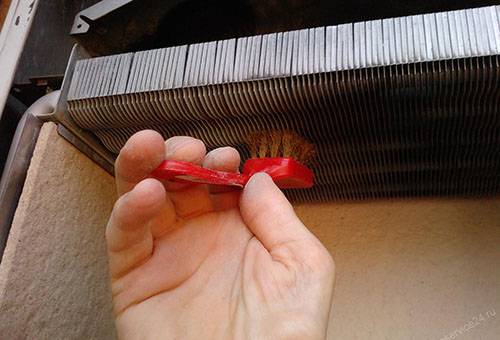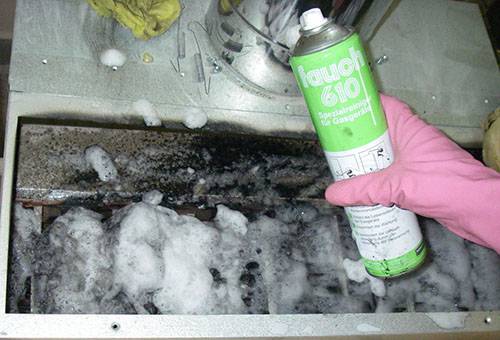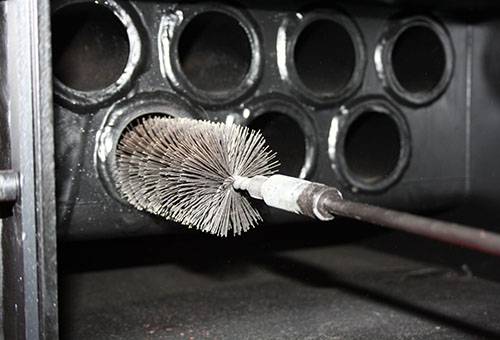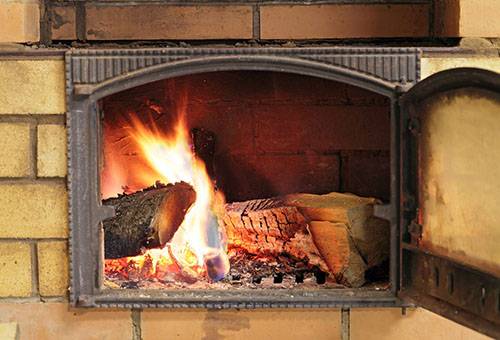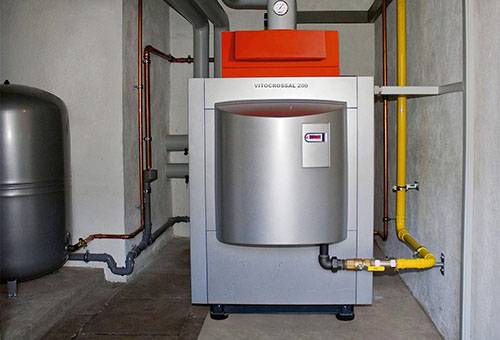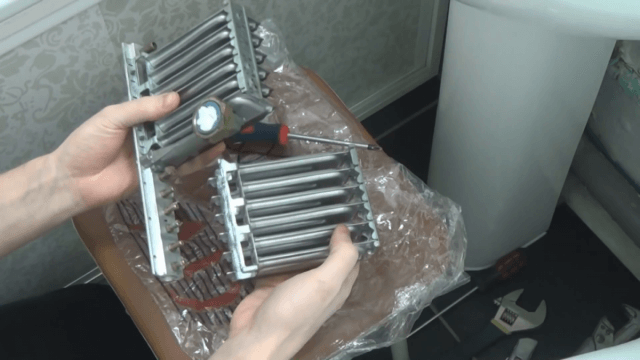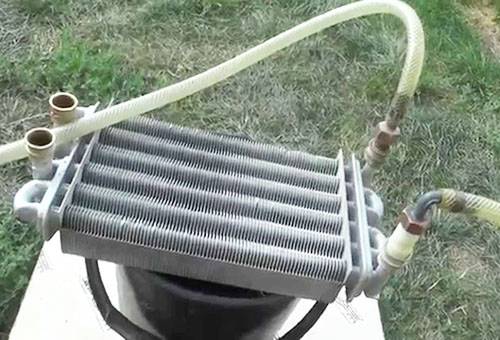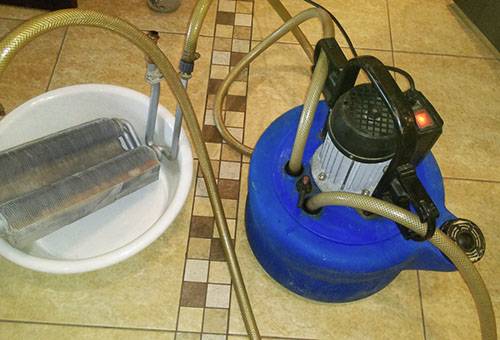How to clean the fire tube heat exchanger of a single-circuit boiler
Cleaning floor-standing boilers with a fire-tube heat exchanger is different from a similar procedure for attachments. Here, for the procedure, the heat exchanger is not removed, but only access to it is provided.
To perform the work you will need the following tools:
- wrenches;
- metal brush-ruff;
- manual brush for metal;
- screwdriver;
- brush made of natural pile or nylon.
The first mandatory action is to turn off the gas supply valve. Next, you need to perform three stages of work - providing access to the heat exchanger, cleaning parts, assembling the boiler. The disassembly / assembly steps depend on the specific model. How to clean the boilers of the MAYAK model - 12 KS, you can see in detail in the video.
Boiler cleaning
When the chimney is contaminated, automatic control systems are usually activated, notifying residents of problems with smoke removal and the need to clean the system. This is not provided inside the boiler, and it is necessary to monitor its contamination on your own so that poisoning by combustion products does not occur, and the device continues to function normally.
Before cleaning the boiler, it is necessary to turn off the gas and power supply, wait until the boiler has completely cooled down, and then carefully disassemble it. Cleaning can be carried out in two ways - chemical and mechanical.
Chemical cleaning
The first option is less dusty, faster. Sulfamic and adipic acids are used, as well as special gels. But chemicals corrode not only the soot itself, but also the metal of the boiler. You can reduce this harmful effect by diluting cleaning products, but making them completely safe for metal will not work. So it is recommended to clean only small contaminants that do not require long-term exposure to the metal.
If, nevertheless, it is decided to use the chemical method for large accumulations of soot, then neat furrows are left on their surface with a brush or scraper, which will help solvents penetrate the soot better. Acids are diluted in water and pumped under pressure into the boiler tank, then they are washed out with a large amount of water.
mechanical cleaning
This method of cleaning involves the physical separation of soot from the surface.
It is also imperfect - this is a lengthy process, and if handled carelessly, it is also harmful to the boiler. Trying to remove soot, its walls can be severely scratched, which will accelerate the corrosion of the metal.
To prevent this, objects that do not have sharp corners are chosen for cleaning. Tools for mechanical cleaning of the boiler often come with it in the kit - these are scrapers, wire brushes, brushes.
The boiler is cleaned either simply with brushes, or various abrasive substances are used with them. For a thin layer of soot of 1-2 mm, ordinary soda is also suitable.
In addition to soot, the cleaning will also remove salts that have settled from the water - scale. From this scale it is necessary to periodically clean the heat exchanger of the boiler, mechanically or chemically. During mechanical cleaning, it is regularly washed with running water, and during chemical cleaning, acids are pre-mixed with water and heated. Gel chemicals do not need to be diluted, but are added to the cooled heat exchanger immediately. They are slightly less effective, but at the same time less aggressive towards the metal.
Filling the boiler with water, boiling it and then draining it will help to significantly reduce the amount of soot. Many boilers also provide for air cleaning - there are holes for supplying pressurized air.
Disassembly and removal of soot
For efficient operation of the equipment, it is necessary to clean the gas column.The deposits formed on the walls can disrupt the smooth operation of the device, so you do not have to wait for a complete failure of the equipment, you should periodically carry out preventive cleaning.
Before starting dismantling, it is necessary to cut off access to gas and water. Do-it-yourself cleaning of the geyser begins with removing the boiler doors and disconnecting the auto-ignition wire. Then the thermocouple, piezoelectric element and burner tube are removed
Carefully remove the nozzle and the burner itself
The thermometer sleeve, the boiler cover, and the flue are removed. The gas column is cleaned using a brush and brushes, which clean all internal and external elements. The nozzle hole is cleaned with a needle with a smaller diameter in order to avoid an increase in the hole and a violation of the combustion regime. The internal channels of the heat exchanger are blown with a vacuum cleaner and wiped with a damp cloth.
At the same time, you can carry out minor repairs to the heat exchanger with your own hands: replace the gasket under the pilot burner, check the thermocouple, which is prone to breakage due to the specifics of operation, and so on. Such work does not require large investments, but maintains the performance of the boiler at a high level, and the thermocouple device is quite simple, and replacing the element is not difficult.
The structure of the gas boiler
Assembly is carried out in reverse order. When connecting the piezoelectric element, it is recommended not to use a tool in order to avoid damage to the ceramic base, it is better to tighten it by hand.
When installing, it is necessary to check the thermocouple on the gas boiler, you need to know that the end of the conductors must be at the level of the place where the flame appears.
How often should the boiler be cleaned
The technical documentation for the boiler indicates how often it needs to be serviced. For closed circuits with the addition of reagents (single-circuit heating boilers), cleaning is required less frequently. It can be performed 1 time in 2-3 years. The bithermic and secondary heat exchangers must be flushed every year, and under difficult operating conditions (“bad” water composition) - twice a year.
Signs that the boiler urgently needs cleaning:
- the boiler is slowly gaining temperature;
- insufficient traction;
- the burner does not ignite or does not burn well;
- with the same gas consumption, the heat output is less;
- traces of soot or partially burnt paint in the area of \u200b\u200bthe viewing window.
Do not neglect preventive measures, because the result of this can be not only broken equipment, but also a threat to the safety of all residents of the house. Clogged chimneys and pipes with growths inside can cause serious accidents.
The nuances of cleaning a gas boiler
When starting to cleanse, you need to know that:
Flushing of boilers should be carried out when they are completely disconnected from electricity, gas and water.
When dismantling the heat exchanger, you should try not to damage the sealing elements, sealing failure will lead to leaks and damage to the unit.
Care must be taken when cleaning the heat exchanger, the thin tubes on the inner surface may be damaged.
A control check for the tightness of the joints can be carried out by coating the joints with soapy water.
When washing in aggressive solutions, it is recommended to add substances - stabilizers. reducing the acid effect on the metal and forming a protective film on the surface of the element. It is best to rinse the gas boiler heat exchanger with special reagents that will be gentle on the material of the unit and qualitatively remove all contaminants
It is best to wash the heat exchanger of a gas boiler with special reagents that will be gentle on the material of the unit and will qualitatively remove all contaminants.
Master Boiler Power removes iron-oxide and carbonate-calcium deposits, does not affect gaskets and seals, the process is accompanied by active foaming, operates at a temperature of 20-40°C.Cleaning is considered completed when the release of foam stops.
Zinconex Powder - removes almost all deposits, contains a color indicator that allows you to control the degree of washing. Compatible with aluminum, galvanized, copper, steel and cast iron surfaces.
Fauch 200, Fauch 610 - spray (aerosol) designed to remove soot from the walls of boilers and heat exchangers.
Effective soot remover HANSA - is a mixture of crystals that burn in the firebox during ignition. It is designed to clean the elements of the boiler and chimneys from soot and tar deposits, reacts with them, destroying the structure of deposits.
Periodic flushing of the gas boiler heat exchanger with your own hands will save the cost of electricity, fuel and the replacement of expensive parts, as well as extend the life of the unit.
do-it-yourself booster for flushing heat exchangers
clean the gas stove
heat exchanger for gas boiler
What is the difference between dry cleaning and mechanical cleaning?
Gas equipment can be cleaned in the following ways:
- mechanical;
- chemical;
- electric discharge;
- hydrodynamic.
Mechanical cleaning is carried out using various brushes and scrapers using physical force.
The process is quite lengthy and must be carried out with care so as not to damage the equipment parts. As a rule, tools for mechanical reading of the unit come with it.
These include: wire brushes, brushes and scrapers.
Mechanical cleaning of the boiler is carried out with brushes and abrasive substances. If the soot layer is small and is no more than 1-2 mm, you can use simple soda
Please note that when cleaning the boiler, it is necessary to remove not only soot, but also scale from water. Scale can be removed from the heat exchanger mechanically or chemically
Mechanical cleaning involves regular flushing of the heat exchanger with running water, and chemical cleaning involves the use of acid mixed with water.
Experts recommend using dry cleaning only for heavily polluted places - chemicals corrode not only soot, but also metal. Although dilution of chemicals with water reduces the harmful effects on the metal, it is impossible to make them completely safe.
Negative effects of deposits and frequency of cleaning
If you do not regularly carry out procedures for cleaning the boiler, then negative consequences cannot be avoided. First of all, heat transfer indicators decrease. The room will warm up slowly and the heat will spread unevenly. The next disadvantage is that more fuel will need to be used, and costs will increase accordingly.
A solid fuel boiler that is not cleaned of ash, soot and tar in a timely manner will not last long, since its main elements responsible for high-quality heating will quickly fail.
By regularly cleaning the pyrolysis boiler, you will ensure not only its efficient operation, but also increase its service life.
The frequency of cleaning procedures for a solid fuel boiler depends on the quality of the fuel used.
If you use high quality firewood, coal, etc., it will be enough to clean the unit once every 30-40 days. If you use low quality fuel with high humidity, then the boiler must be cleaned at least once every two weeks.
https://youtube.com/watch?v=AzjiVKtEHCY
https://youtube.com/watch?v=AzjiVKtEHCY
You can read about the features of pellet boilers here.
How to clean a burner with nozzles
The burner is the most important part, it must be perfectly clean, otherwise there will be no fuel economy. This applies to all types of boilers: wall or floor.
- the gas supply must be shut off;
- the burner is removed from the boiler;
- unscrew the nozzle (it is convenient to take a photo before this in order to know how to put the nozzle back);
- the nozzle is carefully cleaned with a soft brush;
- the burner is cleaned with a brush;
- the burner holes are purged with any pump (ordinary bicycle or automobile);
- the nozzle is inserted back into the burner (do not confuse its location);
- put the burner with the nozzle in place.
Mechanical cleaning of plate heat exchangers
It is possible to clean the boiler from soot without removing the heat exchanger. To do this, just remove the cover, arm yourself with a stiff nylon brush and close the gas nozzles so that dirt does not get there. The whole process is clearly shown in the video:
If the soot has stuck to the surface and is not removed during mechanical processing with a brush, then the heat exchanger is removed and soaked in special washing solutions for several hours. Such products are commercially available in a wide range, such as Fauch and MAZBIT +. But you can also use household chemicals - gels for cleaning grills, ovens.
Before dismantling the boiler, you must disconnect it from the gas, and the igniter from the electricity. In addition, it is necessary to drain the water from both circuits and the expansion tank. The secondary heat exchanger is removed first, it is located immediately behind the boiler cover. It is more problematic to remove the primary (main) one, since you will have to disassemble the combustion chamber.
How to clean interior surfaces
Flushing of the inner surface of a plate, fire-tube or bithermic heat exchanger is possible only with the help of special equipment.
- High pressure pump - hydrodynamic flushing. Used to remove small deposits. Advantages - the speed of the procedure and the possibility of cleaning without removing the heat exchanger.
- Booster (acid-resistant pump) - acid (chemical) flushing. Removes even old scale. Benefits - removes scale that cannot be removed by other methods. Disadvantages - with the wrong selection of reagents (acids and neutralizers), it reduces the service life of the heat exchanger.
- Complex "Streamer" for electric discharge cleaning. Used to remove scale of any strength. Advantages - the metal of the heat exchanger is not destroyed, a high degree of purification is provided. Disadvantages - noise and duration of the procedure.
Of all the methods listed at home, only chemical cleaning is possible, since the factory booster can be replaced with a low-pressure pump. The rest of the equipment is both expensive and bulky, so such washing of boilers can only be done by service centers.
How to clean a gas boiler procedure for each node and do-it-yourself cleaning video
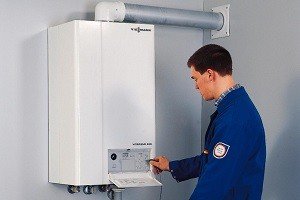
The modern market for heating equipment is saturated with a very wide range of boilers of various types. But a special place in this range is occupied by gas boilers. which are gaining more and more popularity every day.
This trend is due to the fact that units of this type are very efficient and economical devices for heating a country house and even an apartment. In order for the gas boiler to function smoothly and stably, it is necessary to properly care for it.
One of the types of such maintenance is cleaning the gas boiler from soot and other contaminants. Let's talk in more detail about why to clean the gas unit, as well as in what ways this can be done.
Chemical cleaning
In the presence of a booster, flushing can be performed independently. You can make a booster with your own hands - this is a pump and a 10-liter container with two hoses
In order for the procedure to help remove scale, but not damage the metal surface, it is important to choose the right acid. If the boiler is cleaned regularly, there are small deposits on the pipes, then the best way out is to use citric acid.
The concentration of the solution is up to 200 g of acid per 5 liters of water.
If the scale is old or unprepared water with a high mineral content (hard water) is used, you need to take more radical means - compounds based on orthophosphoric, sulfuric or hydrochloric acid. The use of a hydrochloric acid solution without corrosion inhibitors is not recommended as it may damage the equipment.
After acid treatment, it is imperative to flush the heat exchanger with a neutralizer. The alkaline composition is selected based on the acid used. For example, after citric acid, regular baking soda is fine. If you buy a flushing liquid, then it is better to immediately purchase a neutralizer for it: usually companies that produce acidic formulations also offer alkaline ones for neutralization.
Flushing video:
